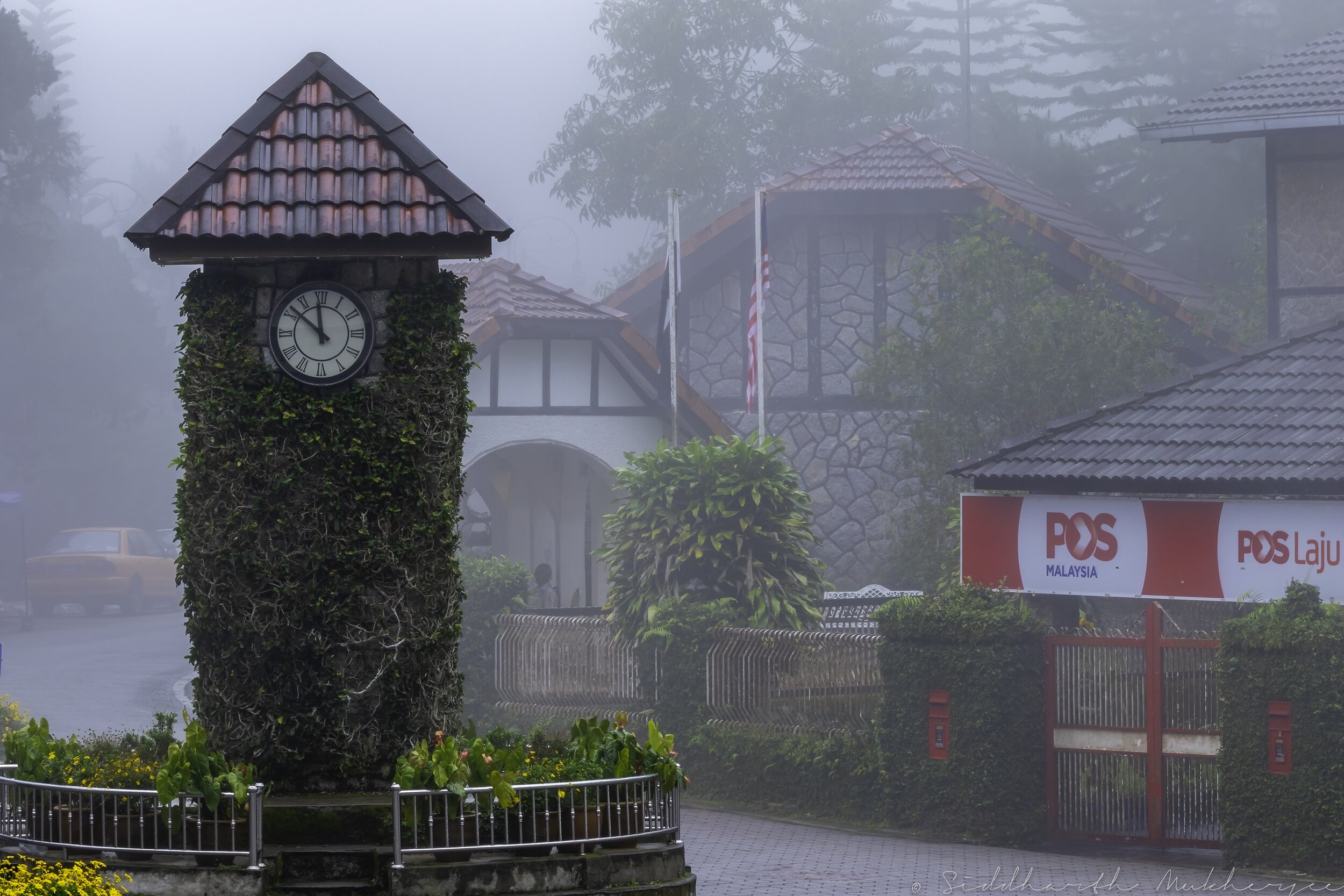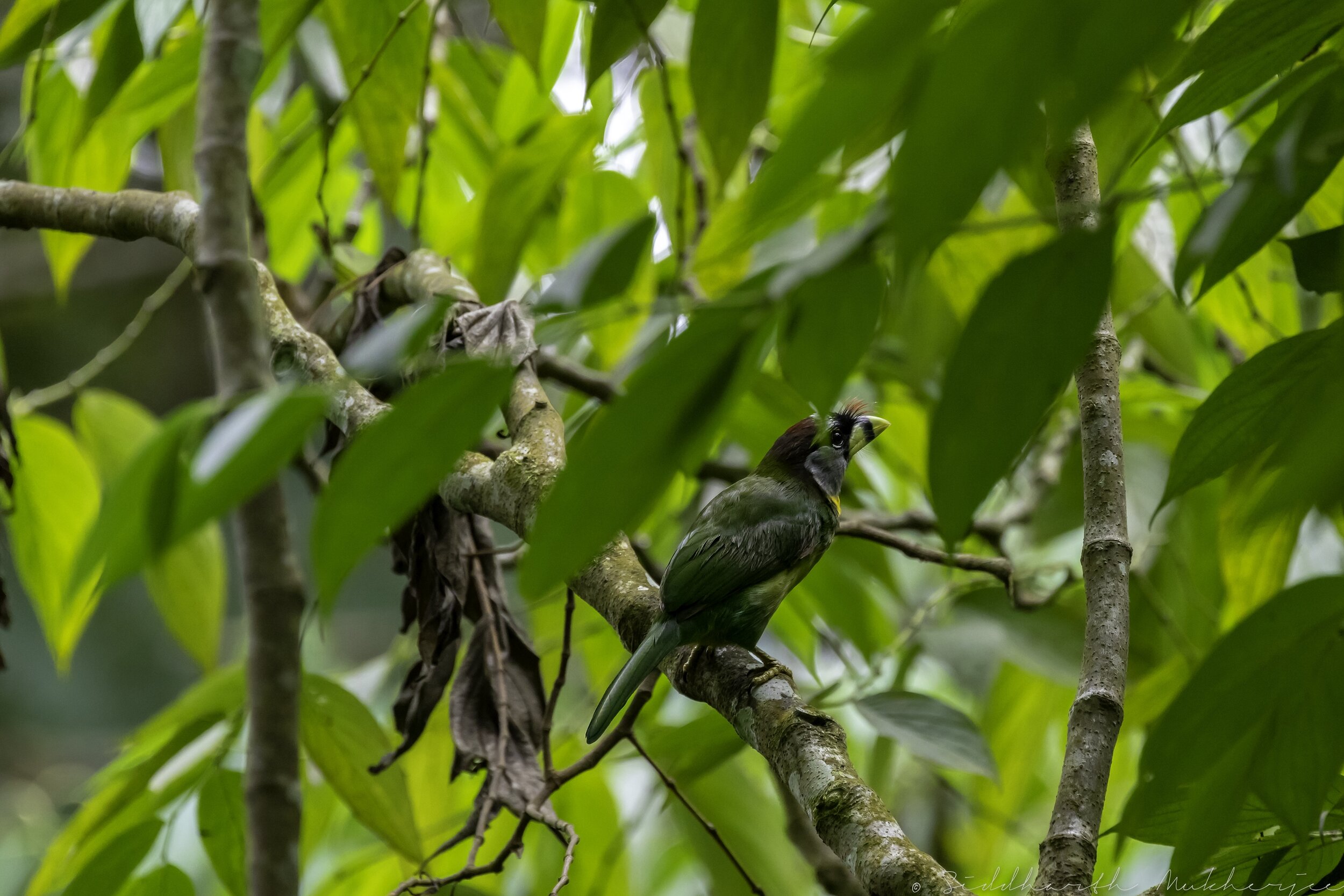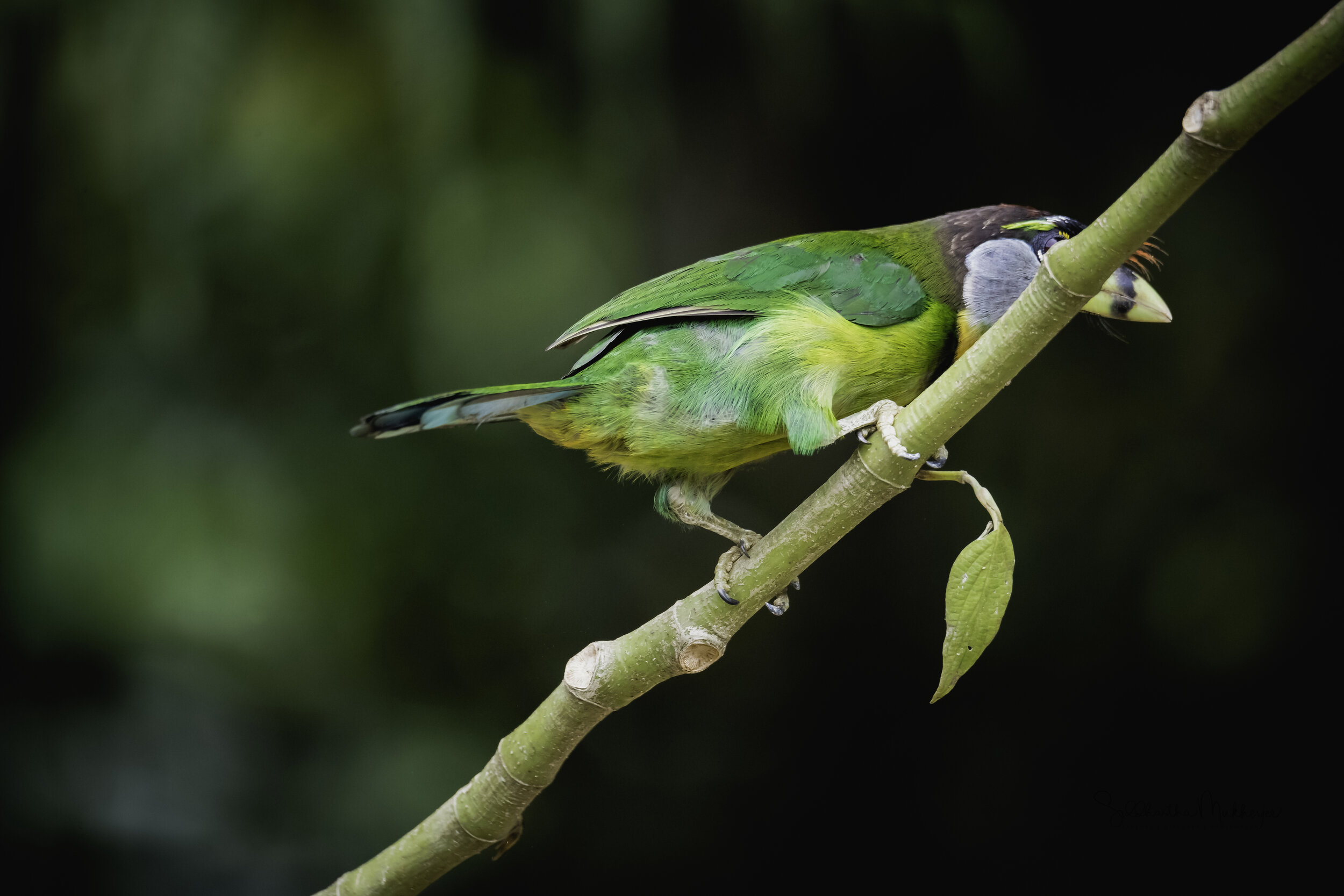Fire-tufted Barbet
Psilopogon pyrolophus
Bukit Fraser, Malaysia
Continuing my wanderings around the pristine evergreen montane forests of Bukit Fraser I came upon the Fire-tufted Barbet (Psilopogon pyrolophus). This is a species of bird in the Asian barbet family Megalaimidae. It is native to Peninsular Malaysia and Sumatra, where it inhabits tropical moist lowland and montane forests. It has been listed as Least Concern on the IUCN Red List since 2004. Its scientific name was proposed by Salomon Müller in 1836, who described a barbet from Sumatra.
The Fire-tufted Barbet is a beautiful emerald-green barbet with silvery cheeks, a white forehead, and a black chinstrap. A small and often difficult to see reddish tuft above the base of the bill gives the bird its name. The bulbous horn-coloured bill has a large dark smudge down the center and it has a strange song which is a loud accelerating creaking that is reminiscent of rusty machinery revving up. I was able to get quite close to it to get this frame filling photo clearly illustrating all its key features.
But first about Bukit Fraser - one of my favourite destinations in Malaysia. Bukit Fraser or Fraser's Hill is a hill resort located on the Titiwangsa Ridge in the Raub District of Pahang, Malaysia. It is about 100 km, about a two hour drive, from the capital Kuala Lumpur and 400 km away from Singapore in the south. Known locally as Bukit Fraser, this quaint holiday retreat is popular for its nature activities and cool weather. It is one of the last hill stations of Malaysia carrying an imprint of its former British colonial masters very similar to some of the well known hill stations (winter capitals) of India.
Fraser's Hill is mountainous terrain where the altitude ranges between 320 m (1,050 ft) and 1,460 m (4,790 ft) above sea level. Around 44% of the terrain area is ranked as steep, while flat areas make up 8% of the overall land area. Fraser's Hill's virgin forest coverage is around 92% of the overall land area, with only 1.5% of the area used for a town. 6.5% of the forest area has been cleared for secondary vegetation. Ten river systems in Malaysia originate in Fraser's Hill, including Sungai Selangor, a major water source for the district of Selangor, and Sungai Teranum, which forms a major river system in eastern Pahang. The geology of the area is predominantly granite, which forms sandy, permeable soil and is easily eroded.
Fraser’s Hill has its roots in the 1890s, when Scottish prospector Louis James Fraser opened up a tin mining community known as Pamah Lebar. Mining activity there was short lived as the tin ore depleted by 1913. This led many miners and farmers to abandon the area and Fraser reportedly disappeared in 1910, but research in 2019 concluded that he retired from his position and returned to Great Britain in 1910. He died in 1916 while travelling in Austria-Hungary. An attempt in 1917 by Charles James Ferguson-Davie, the then bishop of Singapore, to locate Fraser in the area failed. While he searched for Fraser, Ferguson -Davie recognized the area's potential as a suitable location to set up a hill station and provided his suggestions to the high commissioner and chief secretary of the Federated Malay States. Its cool climate made Pamah Lebar an ideal retreat to escape from the usually hot climate in Malaysia and construction began in October 1919 to convert the mine area into a resort. The site was renamed Fraser's Hill and opened to visitors in 1922 and the erstwhile location of Fraser’s tin mine became the location of its golf course.
Subsequent development occurred in the 1970s in response to increased tourism activity. While this provided room for more visitors, it had an impact on the environment including deforestation and water pollution prompting a halt to further developments in April 2010. More species faced extinction and the water pollution affected the lives of the Orang Asli (first people) and residents in nearby villages. These issues led to the Pahang state government ruling out further development in the virgin forest at Fraser's Hill on 13 April 2010.
Fraser's Hill is known for its vast biodiversity which attracts scientists and researchers. In recent years, it has seen an increase in tourist activities including hiking, cycling, golfing, archery, riding, tennis, swimming and squash. With its tiny population of 1,000, as recorded in 2013, it is one of Malaysia’s most unexpectedly satisfying short-stay destinations. Navigating up the tight twists and turns of the road to this hill station is a stimulating experience – in fact the uphill road is so narrow that the final eight kilometre stretch is limited to one-way traffic at any time. The direction changes every hour; odd hours are for ascending the hill, while even hours have been denoted for descending traffic. With a majority of its buildings featuring mock Tudor-style architecture, Fraser’s Hill hasn’t changed much from its days as a British colonial hill resort. Besides the essential photo stop opportunity at Fraser’s Clocktower, a hard-to-miss clock tower which stands in the old English village square, you can head on down to Allen’s Water, a former reservoir turned into a boating and fishing attraction.
Akin to a tiny Scottish hamlet, Fraser’s Hill is one of Malaysia’s premier locations for bird-watching. Avid bird watchers can take advantage of the fact that Fraser’s is home to over 250 species of birds – the Fraser’s Hill Development Corporation and the World Wildlife Fund both run classes and excursions to see the flora and wildlife of the hill station. What's more, the Fraser’s Hill International Bird Race – a contest to document the vast variety of birdlife on the mountainside – is typically held here in June. There are eight nature walk trails available ranging from easy to hard. For example the Maxwell Trail – a short and easy hike or the six-kilometre Pine Tree Trail – a longer trail that takes one past some dramatic views and ends near the 18 foot Jeriau Waterfall located about five kilometres from the town centre. Fraser’s also plays host to the Royal Fraser’s Hill Golf Course – a nine-hole green that is one of Malaysia’s oldest. There’s also a paddock at the eastern edge of the course where one can saddle up for a horse riding session.
With that said, let’s get back to wandering around Fraser’s Hill - this time almost to the Jeriau Waterfall to meet the beautiful emerald-green Fire-tufted Barbet. The photo below illustrates the beautiful and varied shades of emerald green on the bird. I was quite close to the bird, too close in fact, and this photo was just before it flew off only to return a little later.
‡‡‡‡‡
The beautiful and varied shades of emerald green on the Fire-tufted Barbet.
Fire-tufted Barbet
The Fire-tufted Barbet (Psilopogon pyrolophus) is a species of bird in the Asian barbet family Megalaimidae. It is native to Peninsular Malaysia and Sumatra, where it inhabits tropical moist lowland and montane forests. It has been listed as Least Concern on the IUCN Red List since 2004. Its scientific name was proposed by Salomon Müller in 1836, who described a barbet from Sumatra.
This beautiful emerald-green barbet with silvery cheeks inhabits broad-leaved evergreen montane forests between 1,070 and 2,010 meters on the Malay Peninsula and Sumatra. Mainly spotted in the canopy and sub canopy of primary and older secondary forest, forest edges and patches, especially in dense foliage with vines and creepers. Mostly at 900–1500 meters, locally down to 460 meters, and up to 2012 meters.
It is a primarily green barbet of the mountains with males having red-tipped crown feathers, a grey face and a yellow throat patch bordered by a black chest-band. It has a red tuft of feathers at base of its bill which gives it the name. The bill itself is sturdy and with a yellow with an irregular black bar towards the centre. The female lacks the red on the crown while the immatures are duller (e.g. throat patch), greyer, with a sootier crown and chest-band. The nasal tuft is mainly whitish, orbital skin duller, and the eye is always brown (can be red in adult), and has lax plumage.
The fire-tufted barbet is a resident bird and feeds on figs, other fruits, arthropods and insects. Its call is very similar to that of cicadas and about 3–8 seconds long. The notes shorten and increase in tempo from 1–2 to 12–14 per second, “dddzza-ddzza-” to “-zz-zz-zz”, reaching a crescendo before falling away slightly. The also have a whistled note, an incisive “tsink”, a squeak and young give a rasping “teenk”.
Although it is not globally threatened the primary threat to this species appears to be illegal capture and trade as a pet. And though it appears to be under no immediate threat, the clearing of slope forests in its restricted range may soon fragment populations severely. It is present in several protected areas, e.g. Kerinci-Seblat National Park (Sumatra).
The following gallery is of this beautiful emerald-green barbet with silvery cheeks - observed & photographed at Fraser’s Hill almost near the Jeriau Waterfall. The photos are from various trips I have made to this quaint little village town.
‡‡‡‡‡
Calls of the Fire-tufted Barbet recorded at Bukit Fraser.
‡‡‡‡‡
Related Posts
























